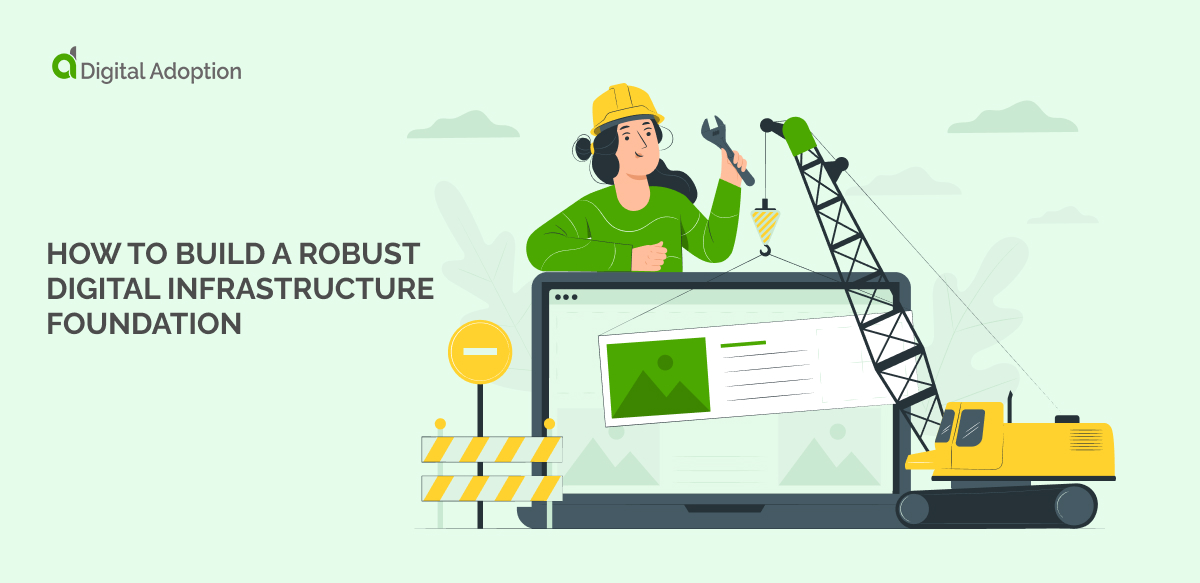As we move through 2022 and beyond, digital transformation (DX) is necessary for contemporary business success—and with it being a process of change, businesses should aim to fortify their technology stack with regular improvements to their digital infrastructure.
Digital infrastructure encompasses the physical and virtual technologies underpinning a company’s information technology (IT) foundation and serves as a critical component facilitating contemporary business IT operations.
However, companies are yet to fully modernize their digital infrastructure, with a McKinsey study finding that business supply chains are only 48% digitized on average, and a mere 2% of business executives surveyed consider supply chain digitization to be a focus of their digital strategies.
A lack of digital adoption can have far-reaching consequences for businesses that maintain physical paperwork, redundant datasets, siloed systems, and analog operations. A failure to digitize operational systems can ultimately lead to business stagnation, inefficient processes, and increased total cost of ownership (TCO).
By adopting the tools needed to quickly and effectively deliver their products and services at scale, businesses can form a solid digital infrastructure foundation to increase business speed, customer satisfaction, and profitability.
In this article, we’ll provide methods organizations can use for building a solid digital infrastructure foundation robust enough to maintain a healthy digital transformation.
Technology Trends Rapidly Changing The Landscape Of Digital Infrastructure:
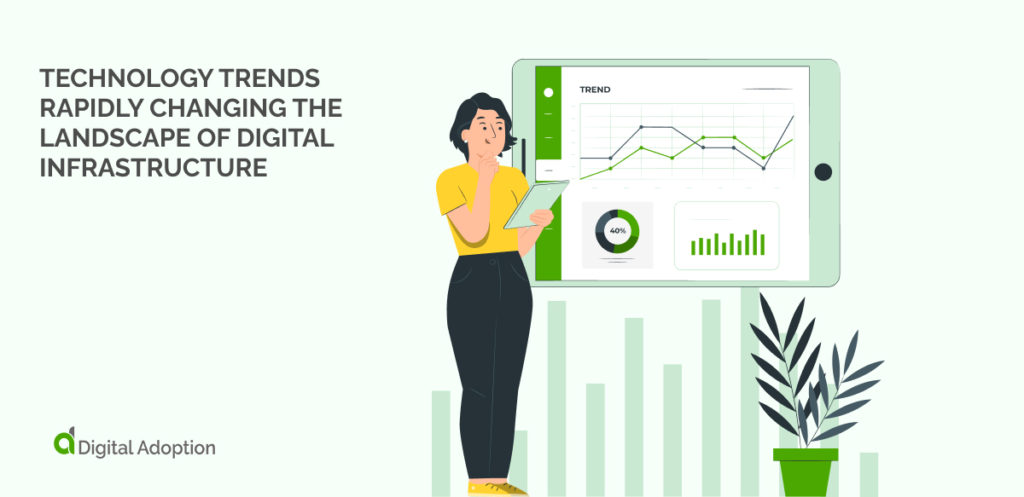
Digital infrastructure includes broadband and mobile telecommunication infrastructure, data centers, systems, networks, Internet of Things (IoT), IaaS, PaaS, and SaaS services.
Shifting economic models caused by the COVID-19 pandemic has spurred rapid technological advancements in recent years and has led to digital transformation falling firmly in the purview of organizations. The Equinix 2020-2021 Global Tech Trends Survey (GTTS) found that 47% of IT decision-makers said their organizations had accelerated their digital transformation initiatives as a direct result of the pandemic, while 60% said they were forced to revisit and revise their IT strategy entirely.
With the dust beginning to settle, businesses are developing more robust, scalable, and dynamic digital infrastructures that can better endure rapid change and adapt to shifting global trends.
Trends will continue to play a significant role in modifying existing processes and creating new opportunities for digital leaders to drive digital and business transformation.
Some key technology trends changing the landscape of digital infrastructure include:
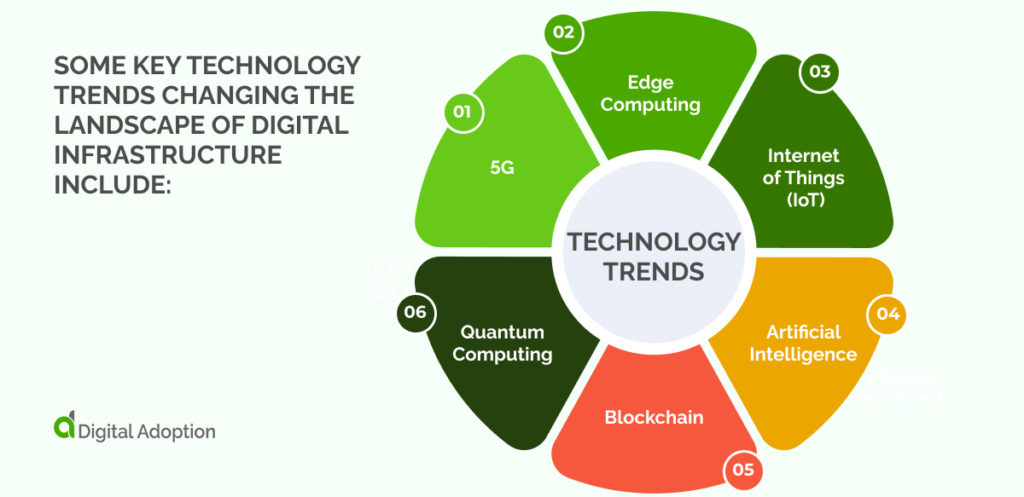
- 5G
This next-generation cellular network technology promises to revolutionize global connectivity, offering much higher speeds and lower latency than 4G networks—its future capabilities help to increase business speed and enhance operational output.
- Edge Computing
Edge computing is a distributed computing paradigm that brings computation and storage closer to data sources. This can help reduce latency, deliver real-time data insights and improve support for IoT networks. Statista projects that the global edge computing market will reach 274 billion U.S dollars in value by 2025, a 97.12% increase from 2019.
- Internet of Things (IoT)
The IoT refers to the network of physical devices and sensors connected to the internet. IoT devices can collect and exchange data and are already an established part of business operations, making them valuable tools for asset tracking, predictive maintenance, and energy management. Gartner reports that 63% of enterprises expect a healthy ROI within three years of launching their IoT projects.
- Artificial Intelligence
Artificial intelligence (AI) is a broad category of technologies that enable machines to perform tasks by mimicking human intelligence. AI systems use complex iterative processing capabilities and intelligence algorithms to execute commands automatically by reading and recognizing data patterns.
Natural language generation (NLG), machine learning (ML), robotic process automation (RPA), and other deep learning technologies within the AI subset are becoming widely used across various sectors, helping to drive business value in healthcare, finance, and manufacturing.
- Blockchain
Blockchain is a decentralized technology that enables secure, transparent, and tamper-proof record-keeping on immutable distributed ledgers. It has many potential applications, from supply chain management and process improvement to identity verification and product authentication.
The global blockchain technology market was valued at 5.92 billion U.S dollars in 2021 and is expected to exceed 1,431.54 billion U.S dollars between 2022 and 2030—registering a CAGR of 85.9%.
- Quantum Computing
Quantum computing is an emerging technology that harnesses the principles of quantum mechanics to perform complex or impossible calculations for classical computers. Quantum computers have the potential to solve complex problems in fields like machine learning and drug discovery.
Digital infrastructure is evolving to keep pace with these rapidly changing technology trends. 5G networks are being built, AI is automating entire processes, and edge computing and IoT devices are already in use. Moreover, blockchain is being integrated into various applications, and advancements in quantum computing are just over the horizon.
As these technologies develop, they will reshape the digital infrastructure landscape and create new opportunities for businesses to induce innovation while outpacing the competition.
Building A Robust Digital Infrastructure
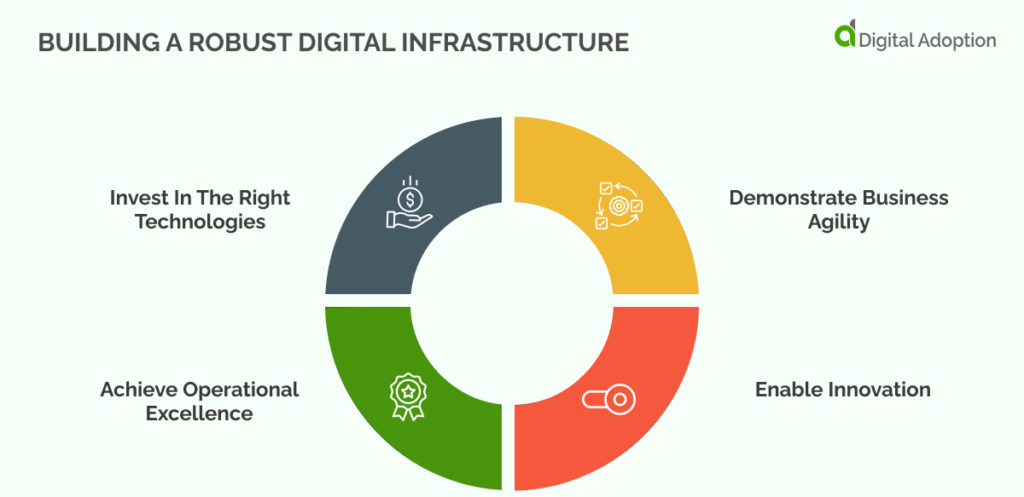
There are several approaches businesses can take to ensure the deployment of digital infrastructure aligns with business goals some of which include a mixture of holistic and actionable solutions.
Invest In The Right Technologies
As digital transformation increasingly becomes a top priority for businesses, investing in the right technologies can allow businesses to innovate processes and gain an edge over competitors. This means clearly understanding your company’s needs and adopting technologies that will best remedy these needs and enable businesses to achieve organizational goals.
Demonstrate Business Agility
To fully leverage the benefits of digital infrastructure, businesses need to demonstrate agility. This means quickly adjusting business practices in response to marketplace changes and deploying new products and services without resistance. The ability to respond to change rapidly is a crucial competitive advantage in the digital age.
Achieve Operational Excellence
Operational excellence is essential for businesses that want to stay ahead of the competition. This means having efficient processes, minimal waste, and high-quality output. Companies can achieve operational excellence by investing in technologies that automate and streamline operations.
Enable Innovation
Innovation is key to success in the digital age. Businesses need to constantly adapt to new market trends, and customer needs to stay ahead of the competition. Technologies such as artificial intelligence and machine learning can help businesses automate processes and make better decisions.
Digital Infrastructure Market Trends

It’s clear—the need for speed, agility, and flexibility has never been greater. Businesses must embrace change and agile digital transformation to navigate the economic uncertainties of today’s world. Shifting trends in the digital economy are ever-changing and complex. Unsurprisingly, digital infrastructure market trends are also prone to these same radical shifts.
Here are some of the key trends that are shaping the digital infrastructure market:
- Digital Is Increasingly Reliant On Edge Infrastructure
Slowly but surely, business and IT leaders are grasping the importance of transitioning their digital systems to the edge instead of solely relying on a single centralized digital core.
By circulating infrastructure throughout different edges, digital leaders can study data more closely to where it originates and attain information rapidly and effectively. In addition, they can use 5G apps with little delay by taking advantage of the full potential offered via edge infrastructure.
- The Digital World Is Increasingly Driven By Developers and Software
As developers gain more control over their organization’s technology decisions, they will prioritize finding ways to make the company more adaptable to new technologies. This goal can be achieved by adopting virtualization, containerization, and automation measures.
Furthermore, the rise of software-defined everything (SDx) will allow businesses to effectively deploy and manage their infrastructure. Also, since end-user demands constantly change, API standardization will enable enterprises to scale their digital infrastructure to meet those changes quickly.
- Reliance On Interconnected Ecosystems Working Will Increase
No digital business, global or otherwise, can succeed in a bubble. They need to be able to take advantage of their own strengths while also quickly making use of the advantageous skillsets of a broad array of partners.
Digital infrastructure is changing to become more partner-centric. Many organizations are now building hybrid multicloud environments, which allows them to connect with multiple cloud providers and optimize performance without the risk of traversing the public internet.
Businesses seek integrations from multiple providers to accommodate physical and digital environments, including on-premises data, cloud access, and colocated resources. Furthermore, they need to be able to retrieve data across a broad spectrum of internal in addition to external sources so their modern applications will perform optimally.
The Future Of Digital Infrastructure?
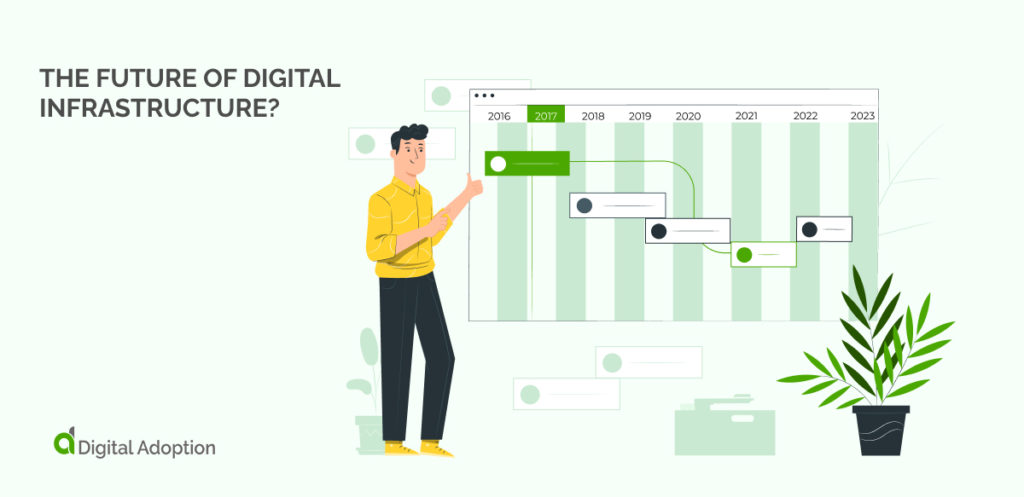
Our expectations for the future of digital infrastructure will develop as business practices evolve to adapt in an increasingly digital-first world.
Accelerating digital infrastructure initiatives will continue to be a key focus for organizations as they seek to drive digital transformation initiatives by investing in new technologies. Doing so enables organizations to fast-track change and deploy infrastructure designed, built, and operated in a way that best supports critical processes.
Gartner predicts, “By 2025, 70% of organizations will implement structured infrastructure automation to deliver flexibility and efficiency, up from 20% in 2021.” When enhancing digital infrastructure, it is essential to clearly understand the organization’s goals and objectives.
To be effective, digital infrastructure must meet an organization’s current and future needs and be designed and implemented to consider security, performance, and manageability. Moreover, interconnecting with partner and customer ecosystems can be great for helping organizations unlock the full value of their investments.
Because prospective business success often hinges on an agile technology portfolio, it means well-equipped infrastructure models suited for competing in the digital arena must be deployed.
With the provision of a robust IT strategy, IT leaders are responsible for delivering solutions that provide a reliable, scalable, and secure digital foundation.
This is pertinent for businesses, governments, and organizations as the interconnected world moves increasingly toward digital transformation.

